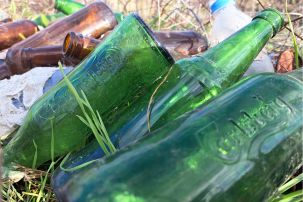Lesson summary
In this activity students look at the waste management systems at their school. Students begin by counting the number and types of bins around the school (including rubbish bins, recycling bins and compost bins). They then look at the contents of the rubbish bins using photographs taken of rubbish bin contents. Based on what they see in the bins, students make an assessment on how successful the waste management systems are at their school.
Learning intentions:
Students will...
- understand that there are a range of different waste disposal systems at their school.
- recognise that not all waste is placed in the correct bins at their school.
Lesson guides and printables
Lesson details
Curriculum mapping
Australian Curriculum content descriptions:
Science Foundation:
- Objects are made of materials that have observable properties (ACSSU003)
- Engage in discussions about observations and use methods such as drawing to represent ideas(ACSIS233)
Mathematics Foundation:
- Sort and classify familiar objects and explain the basis for these classifications. Copy, continue and create patterns with objects and drawings (ACMNA005)
Science Year 1:
- People use science in their daily lives, including when caring for their environment and living things (ACSHE022)
- Participate in different types of guided investigations to explore and answer questions, such as manipulating materials, testing ideas, and accessing information sources (ACSIS025)
Mathematics Year 1:
- Recognise, model, read, write and order numbers to at least 100. Locate these numbers on a number line (ACMNA013)
- Choose simple questions and gather responses(ACMSP262)
Geography Year 1:
- Collect data and information from observations and identify information and data from sources provided (ACHASSI019)
- Reflect on learning to propose how to care for places and sites that are important or significant (ACHASSI026)
Science Year 2:
- Earth’s resources, including water, are used in a variety of ways (ACSSU032)
- People use science in their daily lives, including when caring for their environment and living things (ACSHE035)
Mathematics Year 2:
- Recognise, model, represent and order numbers to at least 1000 (ACMNA027)
- Collect, check and classify data (ACMSP049)
Geography Year 2:
- Collect data and information from observations and identify information and data from sources provided (ACHASSI035)
Science Year 3:
- Science knowledge helps people to understand the effect of their actions (ACSHE051)
Mathematics Year 3:
- Create and interpret simple grid maps to show position and pathways (ACMMG065)
- Identify questions or issues for categorical variables. Identify data sources and plan methods of data collection and recording(ACMSP068)
Geography Year 3:
- Locate and collect information and data from different sources, including observations (ACHASSI053)
- Reflect on learning to propose actions in response to an issue or challenge and consider possible effects of proposed actions (ACHASSI060)
Science Year 4:
- Natural and processed materials have a range of physical properties; These properties can influence their use (ACSSU074)
- Science knowledge helps people to understand the effect of their actions (ACSHE062)
Mathematics Year 4:
- Use scaled instruments to measure and compare lengths, masses, capacities and temperatures (ACMMG084)
- Select and trial methods for data collection, including survey questions and recording sheets(ACMSP095)
Geography Year 4:
- The use and management of natural resources and waste, and the different views on how to do this sustainably (ACHASSK090)
- Locate and collect information and data from different sources, including observations (ACHASSI074)
- Reflect on learning to propose actions in response to an issue or challenge and consider possible effects of proposed actions (ACHASSI081)
Cross curriculum priorities
Sustainability – OI.1 – The biosphere is a dynamic system providing conditions that sustain life on Earth. OI.3 – Sustainable patterns of living rely on the interdependence of healthy social, economic and ecological systems. O1.7 Actions for a more sustainable future reflect values of care, respect and responsibility, and require us to explore and understand environments. O1.9 Sustainable futures result from actions designed to preserve and/or restore the quality and uniqueness of environments.
General capabilities: Numeracy, Critical and creative thinking
Syllabus Outcomes: GE2-3, GE1-3, GE2-4, ST1-11LW, ST1-9ES, ST2-11LW, STe-4WS, STe-9ME, ST2-13MW, MAe‑1WM, MAe‑2WM, MAe‑3WM, MAe‑8NA, MA1‑1WM, MA1‑2WM, MA1‑3WM, MA1‑4NA, MA1-17SP, MA2-11MG, MA2-12MG, MA2-17MG, MA2-18SP, MA2-9MG, MA2‑1WM, MA2‑2WM, MA2‑3WM.
Connecting lessons: Litter audit.
Resources required
- Camera for teacher or photos of bin waste (see activity)
- Student worksheet
Additional info
NOTE: Although this activity has been created in support of the ResourceSmart AuSSI Vic program you will not meet the data goals of the program.
This activity has been created to give younger students – for whom the official waste audit would be too complex – an opportunity to participate in the waste component of the ResourceSmart AuSSI Vic program. To gain accreditation your school will still need to complete the more complex waste audit.


Welcome back!
Don't have an account yet?
Log in with:
By signing up to Cool.org you consent and agree to Cool's privacy policy to
store, manage and process your personal information. To read more, please see
our privacy policy here(Opens in new tab).
Create your free Cool.org account.
Many of our resources are free, with an option to upgrade to Cool+ for premium content.
Already have an account?
Sign up with:
By signing up to Cool.org you consent and agree to Cool's privacy policy to
store, manage and process your personal information. To read more, please see
our privacy policy here(Opens in new tab).